Contents
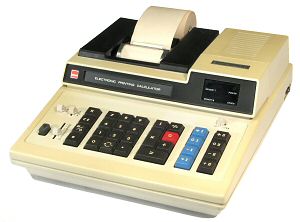
Contents |

|
| Sharp CS-743 printing calculator, 1973 |
The Sharp company of Japan takes its name from the "Ever-Sharp" propelling pencil invented by founder Tokuji Hayakawa in 1915.
Sharp is credited with many of the "firsts" in the early development of electronic calculators, including a fully-transistorised 10-key machine (the CS-10A) in 1964, the first MOS-LSI calculator (the QT-8D) in 1969, the first battery-powered portable calculator (the EL-8) in November 1970, and the first portable LCD calculator (the EL-805) in 1973.
The sequence of Sharp calculators on this page show the rapid progress that was made during the early years of the 1970s - not only in integrated circuit technology, but also in keyboard and display systems, power supplies, and the development of a consistent user interface.
Click on the pictures for larger illustrations, and follow the links for further information.
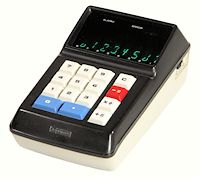 Sharp Model EL-8, S/N 020054Y
Sharp Model EL-8, S/N 020054Y
Functions: ASMD
Technology: MOS-LSI (4 chips), portable, NiCad battery
Display: 8 digits, vacuum fluorescent tubes
Dimensions: 102mm W x 164D x 70H
Weight: 0.72kg including batteries
Manufactured: Sharp, Japan, December 1970.
While the Sharp QT-8B desktop calculator was probably the first electronic calculator to be fitted with internal rechargeable batteries, the Sharp EL-8 from November 1970 was the first to be designed specifically as a portable battery-operated machine. It was advertised at the time as being "the smallest electronic calculator in the world".
The calculator uses a set of four Rockwell MOS-LSI chips in 42-pin flat-packs. The display uses eight individual vacuum-fluorescent tubes, with shaped digits and a distinctive half-height zero. The keyboard uses glass reed switches operated by moving magnets attached to the ends of the keystems. Power is supplied from an internal battery pack (EL-84) containing six AA NiCad cells, with a specialised external charger type EL-81.
One of the charming features of early calculators is the lack of standardisation in the user interface. The EL-8 has both Multiply and Divide marked on the same key - which one you get depends on which Equals key you press afterwards! More...
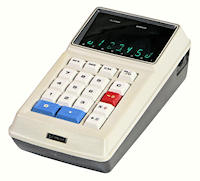 Sharp Model EL-8M, S/N 1228915
Sharp Model EL-8M, S/N 1228915
Functions: ASMD, 1 memory
Technology: MOS-LSI (4 chips), portable, NiCad battery
Display: 8 digits, vacuum fluorescent tubes
Dimensions: 102W x 185D x 70H
Weight: 0.75kg including batteries
Manufactured: Sharp, Japan, April 1971.
The EL-8M from April 1971 is basically an EL-8 with the addition of a single memory register and an extra row of keys. The case has been lengthened by 20mm to accommodate the additional memory keys.
The "M/D" key at the top right switches between memory functions and a "double-precision" mode, in which the calculator can multiply two 8-digit numbers and produce a 16-digit result. More...
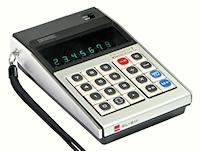 Sharp Model EL-811A, S/N 3005101
Sharp Model EL-811A, S/N 3005101
Functions: ASMD, K, 1 memory
Technology: MOS-LSI (2 chips), portable, NiCad battery
Display: 8 digits, vacuum fluorescent tubes
Dimensions: 105W x 175D x 45H
Weight: 0.56kg including batteries
Manufactured: Sharp, Japan, 1972.
The Sharp EL-811 is a portable battery-powered calculator from 1972. Although only a year later than the first battery portables (the EL-8 and EL-8M above), it shows significant advances in the circuitry, styling, and operator interface.
The calculator has a large wedge-shaped case with brushed metal trim panels and a carrying strap on the left-hand side. The internal construction is very similar to the EL-8. The keyboard now has separate multiply and divide keys, and a double-arrow key to switch between the upper and lower parts of a double-precision result. The display still uses individual VFD tubes (Futaba DG10Q1), but with rectangular 7-segment numerals and a full-height zero. The circuitry uses only 2 processor chips and 3 display drivers, instead of the previous 4 and 9. Power is supplied from the same internal NiCad battery pack and external charger as the EL-8 and 8M. More...
 Sharp Model EL-816, S/N 3020539
Sharp Model EL-816, S/N 3020539
Functions: ASMD, 1 memory
Technology: MOS-LSI (single chip), portable, NiCad battery
Display: 8 digits, vacuum fluorescent tubes
Dimensions: 105W x 175D x 45H
Weight: 0.57kg
Manufactured: Sharp, Japan, 1973.
The EL-816 from 1973 is externally very similar to the EL-811 (above), except for the addition of a "K" key for manual control of the Constant function. The entire keyboard has been moved slightly forward to make space for an additional row of keys.
The display uses individual fluorescent tubes with rectangular 7-segment characters. (The DG10FL tubes actually contain an eighth segment at the centre right to display a "proper" crossed 4, but this segment is not used in the EL-816). The circuitry has been further simplified, with only a single Rockwell 15340 processor chip and two display drivers, all mounted on one single-sided board. The calculator is powered from the same internal Ni-Cad battery pack and charger as the EL-8 and EL-811. More...
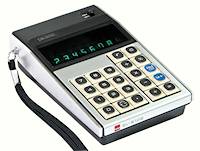 Sharp Model EL-8102, S/N 4204246
Sharp Model EL-8102, S/N 4204246
Functions: ASMD, percent, square root, 1 memory
Technology: MOS-LSI (single chip), portable
Display: 8 digits, vacuum fluorescent tubes
Dimensions: 105W x 175D x 50H
Weight: 0.60kg
Manufactured: Sharp, Japan, 1973.
The EL-8102 is externally similar to the EL-816, but has separate keys for plus, minus, and equals. The double-precision mode and shiftable display have been deleted, and the keys replaced with square root and percentage. The single-chip processor is an NEC uP0277C.
The EL-8102 has an externally-accessible removable battery pack fitted into the underside of the case. The standard pack accomodates six disposable AA batteries, with provision for a 9V 200mA DC plug pack (type EA-13A) for mains operation. An EL-95 NiCad battery pack with six 450mAh batteries was available as an option, with the same EL-81 charger as the earlier 6-cell models. More...
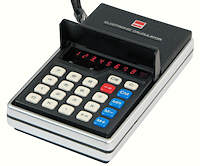 Sharp Model EL-814, S/N 3015931
Sharp Model EL-814, S/N 3015931
Functions: ASMD, constant, 1 memory
Technology: MOS-LSI (2 chips), portable
Display: 8 digits, 7-segment LED modules
Dimensions: 90W x 150D x 32H
Weight: 0.43kg including batteries
Manufactured: Sharp, Japan, 1973.
The EL-814 from 1973 is a four-function calculator which uses a red light-emitting diode (LED) display. Red LEDs were first made in 1962, and were extremely expensive. The introduction of modular seven-segment displays in the early 1970s reduced the cost significantly, but the EL-814 would still have been a very expensive calculator.
The rectangular metal-trimmed case is normally covered by a plastic shutter. Sliding the shutter to the top of the case opens the keyboard, lifts a sun-shade over the display, and turns on the power. The calculator operates in the conventional algebraic manner to 8 significant figures, with a Constant function and a single memory register.
The EL-814 is very nicely built from six modules which simply clip or plug together. The circuitry is on two boards - the CPU board carries the Toshiba T3103 and T3105 processor chips, and the display board carries eight 7-segment LED modules and a T1271 driver chip. There is a custom LED module for polarity and memory indication, and two single LED indicators for Constant and Battery Low. Power consumption is rated at 600mW from 5 AA batteries. The batteries are held in a removable case which clips in place under the keyboard. A re-chargeable NiCad battery pack (EL-91) was available as an option.
EL-814 with cover closed (29kb)
EL-814 component modules (30kb)
EL-814 circuit boards (55kb)
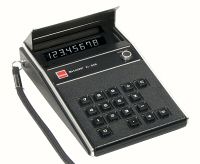 Sharp Model EL-808, S/N 4701443
Sharp Model EL-808, S/N 4701443
Functions: ASMD
Technology: MOS-LSI (single chip), portable, LCD
Display: 8 digits, reflective liquid crystal
Dimensions: 110W x 180D x 40H
Weight: 0.45kg
Manufactured: Sharp, Japan, February 1974.
The EL-808 is a basic 4-function 8-digit calculator in a wedge-shaped casing with plastic trim panels. Its distinguishing feature is the use of a very early (and very expensive) reflective liquid-crystal display which produces bright silver numerals on a black background. The processor is an NEC uPD224C. The calculator draws 350mW from four AA batteries or an external 6V DC supply. More...
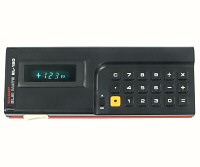 Sharp Model EL-120, S/N 41225563
Sharp Model EL-120, S/N 41225563
Functions: ASMD, count
Technology: MOS-LSI (single chip), portable
Display: 3 digits, single fluorescent tube
Dimensions: 170W x 65D x 20H
Weight: 0.18kg
Manufactured: Sharp, Japan, February 1974.
The EL-120 is a compact portable calculator which uses an early multi-digit vacuum fluorescent display tube from Futaba in Japan. The tube has three multiplexed digits, a polarity sign, and two comma indicators mounted side-by-side in a glass tube about 65mm long. It is attached to the circuit board by flying leads from one end.
The calculator operates to 12 digits, which are displayed in groups of three (units, thousands, millions, etc). The operator can scroll the sections of the display with the yellow key, or have them scroll continuously by setting the A/M switch to A. The calculator has a white "Count" button on the lower edge which increments the integer display by one unit, and there is a 15cm ruler marked on the underside of the case.
The EL-120 has an elastomeric keyboard and a Hitachi HD3583 single-chip processor, with power supplied by three AA batteries. More...
 Sharp Model EL-122, S/N 41193137
Sharp Model EL-122, S/N 41193137
Functions: ASMD
Technology: MOS-LSI (single chip), portable
Display: 6/12 digits, 6-digit fluorescent tube
Dimensions: 88W x 143D x 42H
Weight: 0.28kg with batteries
Manufactured: Sharp, Japan, June 1974.
The EL-122 has a wedge-shaped case similar to the EL-816, but
slightly smaller and with plastic trim panels on the sides. The
calculator works to 12 digits on all operations, with the results
displayed in two groups on a 6-digit fluorescent tube. The keyboard
has a double-arrow key to select the upper or lower group, and a red
LED indicator to show when the lower group is being displayed. The
EL-122 uses a NEC μPD227C procesor, and draws 500mW from 3
AA batteries.
Internal view (29kb).
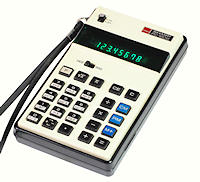 Sharp Model PC-1802 "Digital Rule", S/N 51063801
Sharp Model PC-1802 "Digital Rule", S/N 51063801
Functions: ASMD, scientific
Technology: MOS-LSI (single chip), portable
Display: 8 digits, double-ended fluorescent tube
Dimensions: 89W x 148D x 36H
Weight: 0.35kg
Manufactured: Sharp, Japan, 1974.
Sharp entered the "scientific" calculator market in 1973 with the PC-1001, a compact desktop machine using a Rockwell microprocessor chip set. This was followed in 1974 by the portable PC-1802 "Digital Rule", intended as an electronic replacement for the traditional engineer's slide rule. Although it provides "scientific" functions it does not use scientific notation, and is limited to an 8-digit floating-point display. Trig and log functions and their inverses are only accurate to 6 digits, but are still 3 digits more accurate than the 10" slide rule.
The PC-1802 is built in a modular fashion similar to the EL-814 above. The single circuit board carries the Rockwell 15470PA processor, the power supply, and a 9-digit fluorescent display tube. The rightmost digit is reserved for minus and memory indicators. The extra connections needed for 9 digits required a new double-ended tube construction with flying leads at each end.
The CPU board connects to the elastomeric keyboard via
a 15-pin plug and socket. The scientific functions share the numeric
keys and are accessed via a single "F" key, with the keytops marked
in a similar manner to those on the PC-1001. A slide switch selects
degrees or radians for the trig functions. The calculator draws
about 400mW from 5 AA batteries or an external EL-97 adaptor. It
uses the same removable battery pack as the EL-814 (above), but does
not have the provision for re-charging a Ni-Cad battery pack.
Sharp PC-1802 CPU board
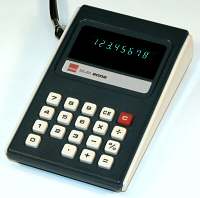 Sharp Model EL-8002, S/N 41228218
Sharp Model EL-8002, S/N 41228218
Functions: ASMD, percent
Technology: MOS-LSI (single chip)
Display: 8 digits, double-ended fluorescent tube
Dimensions: 88W x 143D x 42H
Weight: 0.27kg including batteries
Manufactured: Sharp, Japan, October 1974.
The EL-8002 is generally similar to the EL-122 above, but with 8-digit operation and an 8-digit display. The double-arrow key is no longer needed and has been replaced with a percent key. The double-ended display tube has 9 (smaller) digits, with one place reserved for polarity and error indication.
The rapid development of the multi-digit fluorescent tube greatly
reduced the size and power requirements, leading to a portable 8-digit
calculator drawing less than 300mW from three disposable AA batteries.
The EL-8002 uses an elastomeric keyboard (similar to the EL-120),
with a Hitachi HD3623 processor.
Circuit board and display tube (29kb).
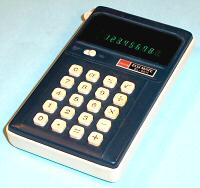 Sharp Model EL-8011, S/N 58112120
Sharp Model EL-8011, S/N 58112120
Functions: ASMD, percent, square root
Technology: MOS-LSI (single chip)
Display: 8 digits, vacuum fluorescent display (single tube)
Dimensions: 80W x 135D x 25H
Weight: 0.23kg including batteries
Manufactured: Sharp, Korea, 1975.
The EL-8011 was built in Korea (rather than Japan) in 1975. It has a plain rectangular case, and is slim enough to be almost pocket-size. It has an elastomeric keyboard and a double-ended vacuum fluorescent display tube. The processor is a Hitachi HD36290, with power supplied from four disposable AA batteries.
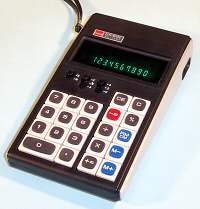 Sharp Model EL-1101, S/N 59003116
Sharp Model EL-1101, S/N 59003116
Functions: ASMD, K, percent, 1 memory
Technology: MOS-LSI (single chip), portable
Display: 10 digits, vacuum fluorescent module
Dimensions: 100W x 175D x 45H
Weight: 0.43kg including batteries
Manufactured: Sharp, Japan, June 1975.
The EL-1101 is a 10-digit portable calculator in a larger casing
with metal trim panels, similar to the EL-816 (above). In order to
produce fluorescent displays of more than 8 digits the tubular
construction had to be replaced with a new flat-panel design. The
flying leads were replaced with a semi-rigid in-line connector strip
which allowed many more connections and greatly simplified the
assembly. The EL-1011 has an 11-digit display module, with one place
reserved for polarity and error indication. Power is supplied from
four disposable AA batteries, a special Ni-Cad battery pack, or an
external AC adaptor and charger. The single-chip processor is a
Hitachi HD3683.
More...
Circuit board and display panel (27kb).
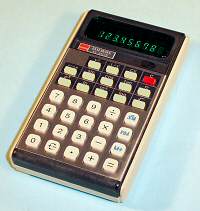 Sharp Model EL-8113S, S/N 61000844
Sharp Model EL-8113S, S/N 61000844
Functions: Scientific, pocket/battery
Technology: MOS-LSI (single chip)
Display: 8 digits, vacuum fluorescent display
Dimensions: 80W x 135D x 30H
Weight: 0.23kg including batteries
Manufactured: Sharp, Japan, 1975.
The EL-8113S is a pocket-size calculator which includes "scientific" functions (trig, logs,and powers) but not "scientific" notation. The "F" key and the inverse trig functions of the PC-1802 (above) have been deleted, and the remaining functions now have their own individual keys. The floating-point display shows 8 digits with no round-off, and is accurate to 6 digits on the scientific functions (similar to the PC-1802). The calculator uses a Hitachi HD3685 processor and a compact flat-panel fluorescent display module. It is powered from four disposable AA batteries, or an external AC adapter.
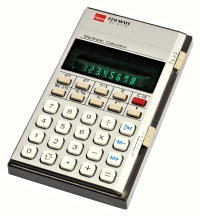 Sharp Model EL-8118, S/N 62087847
Sharp Model EL-8118, S/N 62087847
Functions: Scientific, pocket/battery
Technology: MOS-LSI (single chip)
Display: 8 digits, vacuum fluorescent display
Dimensions: 80W x 137D x 22H
Weight: 0.19kg including batteries
Manufactured: Sharp, Japan, 1976.
The EL-8118 from 1976 is an "8-digit + memory" calculator with 8 extra keys for some basic mathematical functions. The new-style case is only 22mm thick, with slide switches along the top-right edge. The calculator uses a Hitachi HD37351 processor and a 9-digit fluorescent display module. It draws about 300mW from two disposable AA batteries, a rechargeable NiCad battery EA-18B, or an external AC adapter/charger EA-17E.
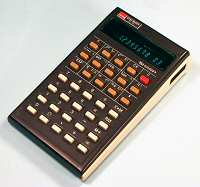 Sharp Model EL-501, S/N 8600286Y
Sharp Model EL-501, S/N 8600286Y
Functions: Scientific, pocket/battery
Technology: MOS-LSI (single chip)
Display: 8 digits, 2 exponent, vacuum fluorescent display
Dimensions: 80W x 140D x 30H
Weight: 0.23kg including batteries
Manufactured: Sharp, Japan, September 1977.
The Sharp EL-501 is a pocket-size scientific calculator that was small and cheap enough to be widely used by senior school students in the late 1970s. The keyboard layout has been further refined with the return of the "F" key, so that most of the extra keys now perform either the labelled function or its inverse. The EL-501 uses a compact fluorescent display module with scientific notation, displaying "8+2" digits in less than 50mm width. The processor is from Hitachi (36128), and the power supply is from two AA batteries.
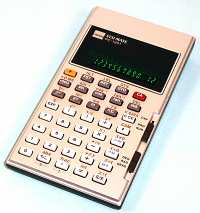 Sharp Model PC-1201, S/N 7400100Y
Sharp Model PC-1201, S/N 7400100Y
Functions: Scientific, programmable, pocket/battery
Technology: MOS-LSI (three chips)
Display: 10 digits, 2 exponent, vacuum fluorescent display
Dimensions: 80W x 150D x 20H
Weight: 0.21kg including batteries
Manufactured: Sharp, Japan, October 1977.
Sharp described the PC-1201 as a "Pocket Computer" rather than a "Programmable Calculator", although it is generally similar to other advanced calculators of the time.
The calculator provides a full range of scientific functions which are generally accurate to 9 places.
The programming capability provides 128 steps and includes labels, conditional branching, and one level of subroutine calls. Programs can be reviewed and edited from the keyboard, and are retained for up to a year by a separate memory backup battery. The calculator was supplied with a 260-page applications manual giving sample programs from mathematics, surveying, finance, and engineering.
The circuitry uses three LSI chips in 58-pin surface-mount flatpacks on a double-sided board, with a 14-digit Futaba display module. The calculator can be powered from two AA batteries, a special NiCad battery pack, and/or an external AC adaptor. More...
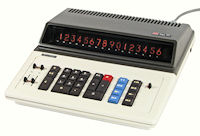 Sharp Model CS-363, S/N 11001705
Sharp Model CS-363, S/N 11001705
Functions: ASMD, K, 3 memories
Technology: MOS-LSI (Rockwell, 6 chips)
Display: 16 digits, Nixie tubes
Dimensions: 295W x 335D x 100H
Weight: 3.9kg
Manufactured: Sharp, Japan, March 1971.
The Sharp CS-363 is a four-function desk calculator with a 16-digit Nixie-tube display and three memory registers. The blue keys at the right of the keyboard operate memory MI, while the black keys operate either MII or MIII depending on the setting of the adjacent slide switch. The reed-switch keyboard has provision for a third set of memory keys, which are not installed on this model. The switches at the left of the keyboard set the decimal places and roundoff modes for the display and memory separately. The processor uses a set of 6 Rockwell MOS-LSI chips (10061 to 10066) in 42-pin flat packs. The chips have date codes from November 1970 to February 1971, and the circuit boards are dated March 1971.
An extended version of the CS-363 with three rows of memory keys
and a square root function was custom-built by Sharp for the Swedish
Facit organisation. Please see the
Facit 1135J page for further
details.
CS-363 processor board (34kb)
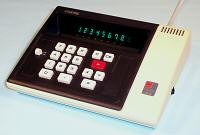 Sharp Model EL-803, S/N 3011182
Sharp Model EL-803, S/N 3011182
Functions: ASMD, K key
Technology: MOS-LSI (single chip)
Display: 8 digits, vacuum fluorescent tubes
Dimensions: 180W x 190D x 75H
Weight: 1.5kg
Manufactured: Sharp, Japan, December 1972.
This Sharp EL-803 is a basic four-function desk calculator
from 1972. The single-chip processor (Hitachi HD3276) requires
four additional chips to drive the fluorescent display tubes.
Internal view (30kb)
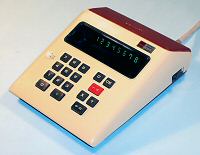 Sharp Model EL-804, S/N 3100707X
Sharp Model EL-804, S/N 3100707X
Functions: ASMD, K key
Technology: MOS-LSI (single chip)
Display: 8 digits, vacuum fluorescent tubes
Dimensions: 180W x 230D x 75H
Weight: 1.25kg
Manufactured: Sharp, Japan, July 1973.
The Sharp EL-804 from 1973 has the same functions and the same processor chip as the EL-803, but differs in the packaging and the display driver circuitry.
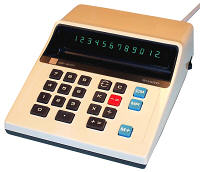 Sharp Model CS-2101, S/N 46209702
Sharp Model CS-2101, S/N 46209702
Functions: ASMD, K key, 1 memory
Technology: MOS-LSI (single chip)
Display: 12 digits, vacuum fluorescent tubes
Dimensions: 180W x 230D x 75H
Weight: 1.22kg
Manufactured: Sharp, Japan, November 1973.
This CS-2101 from late 1973 is a more elaborate four-function desk
calculator with a 12-digit flat-panel display. It has a single memory
register accessed through the blue keys on the right-hand side. The
modular keyboard assembly has an un-used position where we would now
expect to find the "M-" key. Although the procesor chip is branded
"Sharp", the part number (15352) and the staggered-pin packaging
suggest that it was actually made by Rockwell.
Circuit board detail (28kb)
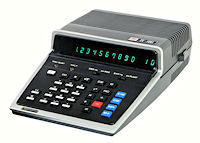 Sharp Model PC-1001, S/N 31048812
Sharp Model PC-1001, S/N 31048812
Functions: Scientific, programmable
Technology: MOS-LSI (5 chips), mains power
Display: 10 digits, 2 exponent, vacuum fluorescent tubes
Dimensions: 140W x 225D x 70H
Weight: 1.06kg
Manufactured: Sharp, Japan, November 1973.
The PC-1001 from 1973 is a programmable scientific calculator in
a compact desktop case. It provides scientific notation, trig and log
functions, 8 directly-accessible memory registers, and is programmable
from the keyboard. The circuitry is built from a general-purpose
4-bit microprocessor system (the Rockwell PPS-4) rather than a
dedicated calculator chipset.
More...
 Sharp Model PC-1002, S/N 41006506
Sharp Model PC-1002, S/N 41006506
Functions: Scientific, programmable
Technology: MOS-LSI (6 chips), mains power
Display: 10 digits, 2 exponent, vacuum fluorescent tubes
Dimensions: 140W x 225D x 80H
Weight: 1.17kg
Manufactured: Sharp, Japan, 1974.
The PC-1002 from 1974 is an expanded version of the PC-1001 above.
It provides additional scientific functions and basic statistics
(mean and standard deviation), and includes a user-accessible IC
socket for optional pre-programmed ROM modules.
More...
 Sharp CS-743R Printing Calculator, S/N 31490607
Sharp CS-743R Printing Calculator, S/N 31490607
Functions: ASMD, K, percent, 2 memories
Technology: MOS-LSI (4 chips)
Display: 18-column impact printer
Dimensions: 260W x 320D x 110H
Weight: 5.6kg
Manufactured: Sharp, Japan, 1973.
Sharp's CS-743R from 1973 uses a Shinshu Seiki (later renamed to Epson) EP-102 modular impact printer to record all entries, operations, and results on a 57mm paper tape. The calculator has no separate numerical display - but then, neither did most of the mechanical adding machines that it was designed to replace.
Addition and subtraction operate in the traditional adding-machine fashion with total and sub-total keys, while multiplication and division operate algebraically. There are two independent memory registers which are accessed via the blue and black keys on the right-hand side. The memory controls are also labelled with total and sub-total, rather than the now-familiar "recall" and "clear" functions. There are two indicator lamps to show when the memories are active. The keyboard mechanism is built in several sections, using glass reed switches operated by magnets on the ends of the key stems.
The calculator circuitry uses four main LSI chips in 24-pin
ceramic packages, 15 smaller chips in 14 and 16-pin packages, over 40
discrete transistors, and a host of individual components. The IC
chips are all from NEC.
Internal view (38kb)
 Sharp Compet CS-523R Printing Calculator, S/N 49029203
Sharp Compet CS-523R Printing Calculator, S/N 49029203
Functions: ASMD, K, percent
Technology: MOS-LSI (2 chips)
Display: 15-column impact printer
Dimensions: 250W x 320D x 110H
Weight: 4.5kg
Manufactured: Sharp, Japan, 1974.
The CS-523 is a smaller and simpler print-only calculator from early 1974. The processor uses two NEC chips (μPD221 and 222) in 28-pin packages, with only one support chip. The case has mountings for the EP-102 printer, but is fitted with a smaller 15-column EP-104 mounted on elevated brackets. The keyboard uses separate key switches which are individually screwed to a metal baseplate. Operation is the same as for the CS-743 above, apart from the lack of memory keys.
The CS-523 circuit board is drilled and labelled for 4 additional
16-pin chips, and has mountings on the keyboard for 4 additional keys,
so there is presumably another model which includes the memory
functions. The Facit Model
1148 (made by Sharp for the Swedish Facit company) uses
the same chipset with the additional components installed.
Internal view (29kb)